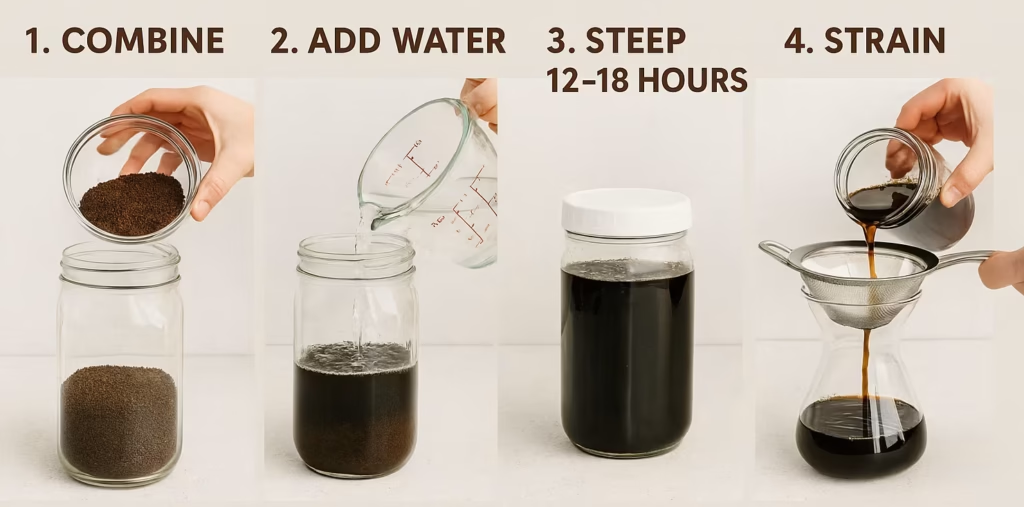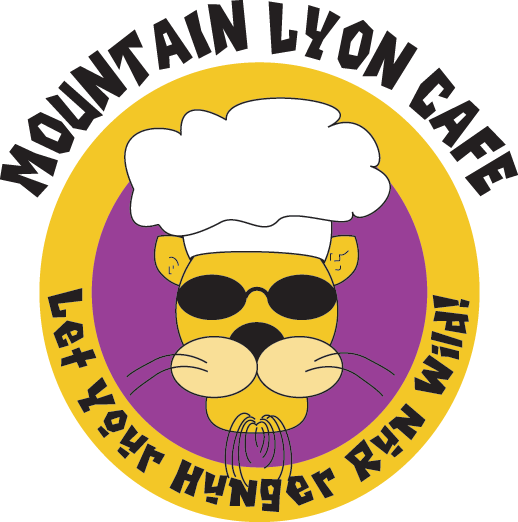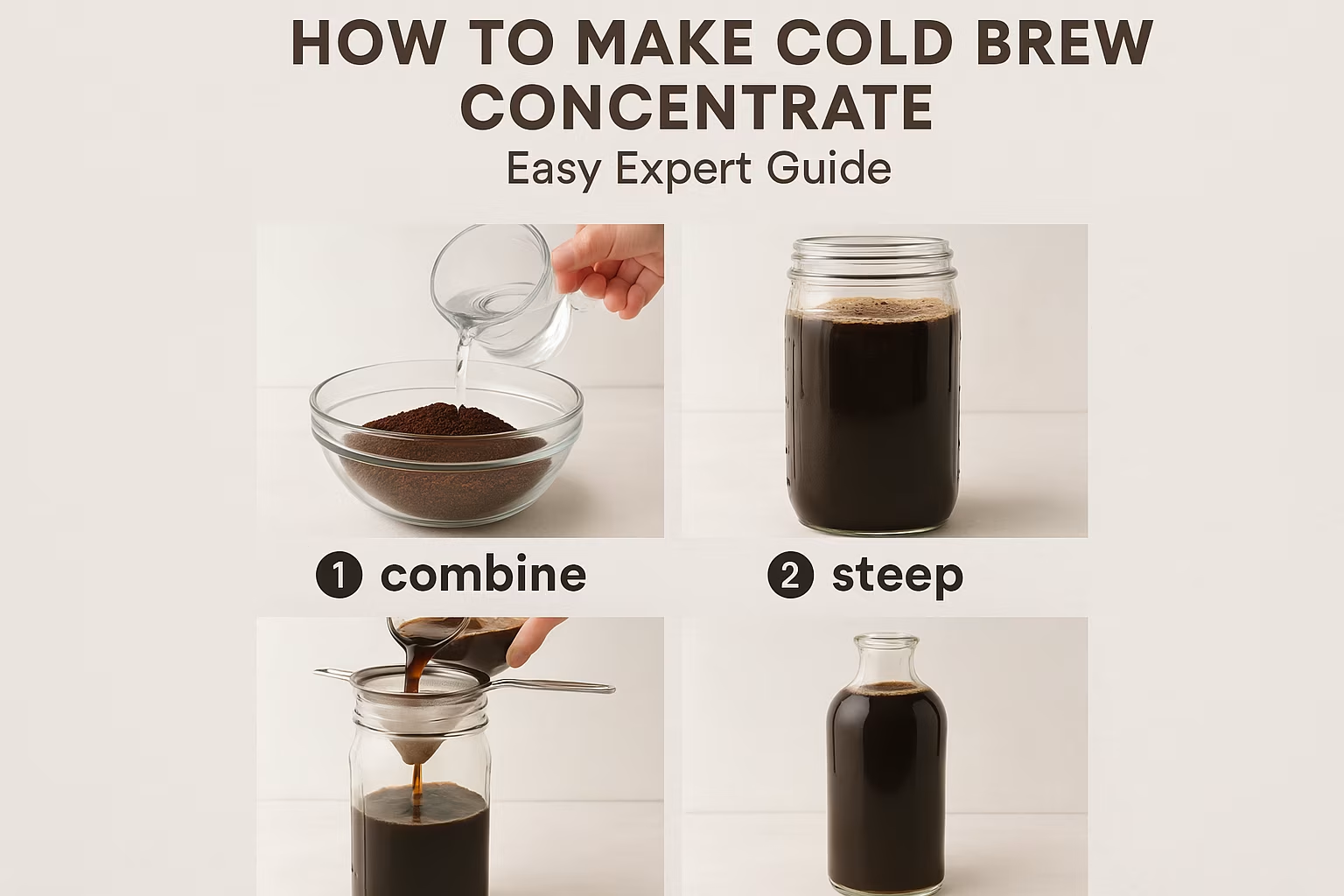Learn how to make cold brew concentrate at home with the right beans, water ratio, and steeping time. Discover tips, common mistakes, and creative ways to use cold brew for lattes, desserts, or cocktails—all in one complete guide.
How to Make Cold Brew Concentrate: Easy Expert Guide
If you’ve ever sipped on a glass of smooth, refreshing cold brew coffee concentrate, you know it’s unlike any other coffee experience. Unlike hot coffee that can sometimes taste bitter or overly acidic, cold brew concentrate delivers a rich, chocolatey, and naturally sweet flavor that’s both versatile and easy to make at home. Whether you want to enjoy it straight over ice, mix it into a creamy latte, or even use it in baking, learning how to make cold brew concentrate is one of the most useful coffee skills for home brewers.
In this article, you’ll not only learn the step-by-step process but also discover the best coffee beans, the right cold brew concentrate ratio, steeping times, storage tips, and even creative recipes—all backed by expert tips and timeless wisdom from coffee culture worldwide.
Step-by-Step: How to Make Cold Brew Concentrate at Home

The first and most important thing people search for is the actual process: how to make cold brew concentrate in a simple, reliable way. Let’s break it down clearly.
Ingredients You Need for Cold Brew Concentrate
Freshly roasted coffee beans (preferably medium to dark roast for a bold flavor)
Filtered water (poor water = poor coffee; always use clean water)
A large mason jar, French press, or cold brew maker
A coarse coffee grinder (this ensures you don’t end up with over-extracted, muddy concentrate)
Pro tip: Coffee legend James Hoffmann often emphasizes that water quality is just as important as bean quality. Using clean, filtered water enhances the natural sweetness of your cold brew.
Brewing Equipment: What Works Best
You don’t need fancy equipment to make cold brew concentrate. Here are your main options:
Mason Jar Method: The most affordable way. Simply mix ground coffee and water in a jar, steep, then strain.
French Press Method: Convenient for straining since the built-in plunger works as a filter.
Cold Brew Makers: Designed specifically for the process; these often include reusable filters and precise measurements.
Each has its pros and cons, but all will give you excellent results if you follow the right steps.
Brewing Process: Grind, Steep, Strain
Grind the beans: Use a coarse grind, similar to raw sugar. Fine grinds will clog filters and create bitterness.
Mix coffee and water: The golden starting ratio is 1 cup of coffee beans to 4 cups of water. Adjust to your taste.
Stir gently to ensure all grounds are fully saturated.
Steep: Cover the container and let it sit for 12–24 hours.
Strain: Use a cheesecloth, paper filter, or French press to separate the liquid concentrate from the grounds.
And just like that, you’ve made your first batch of cold brew concentrate.
Choosing the Best Coffee Beans for Cold Brew Concentrate
The beans you choose dramatically influence the flavor of your concentrate. If you’ve ever wondered why your cold brew tastes different at a café compared to home, it’s often because of the bean selection.
Arabica vs Robusta: Which One Works Better?
Arabica beans: Known for their smooth, complex, and sweet notes. Ideal for those who want a refined cold brew.
Robusta beans: Stronger, more caffeinated, and earthier. They deliver more punch but less sweetness.
Blend approach: Many roasters create special cold brew blends combining Arabica for flavor and Robusta for caffeine strength.
Roast Levels: Light, Medium, or Dark?
Light roast: Fruity, tea-like flavors but may taste too sharp in cold brew.
Medium roast: Balanced acidity and body; often the best choice.
Dark roast: Bold, chocolatey, and strong; perfect for those who like a deep, rich concentrate.
A famous quote from coffee writer Kenneth Davids reminds us: “Coffee is a language in itself.” Choosing your roast is like choosing a dialect—each tells a different story in your cup.
Grind Size: Why Coarse Grind Matters
When making cold brew concentrate, grind size matters more than you think. A coarse grind ensures slow extraction, preventing bitterness. Too fine, and your concentrate will be cloudy, gritty, and harsh. Imagine trying to sip sand—that’s what happens if you ignore grind size.
Cold Brew Concentrate Ratios and Steeping Times
The ratio of coffee to water and the time you let it steep are the keys to a perfect cold brew. This is where science meets art.
Ideal Coffee-to-Water Ratio
Most experts recommend:
1:4 ratio (1 part coffee, 4 parts water) for concentrate
1:8 ratio for ready-to-drink cold brew
| Ratio | Strength | Best For |
|---|---|---|
| 1:4 | Strong, concentrated | Mixing with milk, cocktails, cooking |
| 1:6 | Balanced | General home use |
| 1:8 | Light, ready-to-drink | Direct iced coffee |
Tip: Always measure by weight (grams) instead of scoops for precision.
Steeping Time: 12, 16, or 24 Hours?
12 hours: Lighter, tea-like flavor
16 hours: Balanced, rich taste
24 hours: Strong, bold, sometimes bitter if beans are too dark
As the proverb goes, “Good things come to those who wait.” Patience in steeping rewards you with a smoother, more flavorful concentrate.
Room Temperature vs Refrigerator Brewing
Room Temperature: Extracts faster, often ready in 12–16 hours. Produces a fuller body.
Refrigerator: Slower extraction, usually takes 18–24 hours. Produces a cleaner, lighter brew.
Many baristas argue that cold brewing in the fridge preserves sweetness better, while room temperature brings out richness. The choice is yours.
Why Choose Cold Brew Concentrate? Benefits Explained
Why go through the trouble of making cold brew concentrate when you could just brew hot coffee and pour it over ice? The answer lies in its unique benefits.
Smooth Flavor and Low Acidity
Cold brew concentrate has up to 67% less acidity than hot coffee, according to studies published by Toddy, one of the pioneers of cold brew equipment. This makes it gentler on the stomach and better for those sensitive to acid.
Versatility: Dilute, Mix, or Cook
One of the greatest benefits is flexibility. You can:
Dilute with water for a smooth iced coffee
Mix with milk for a creamy cold brew latte
Use in cocktails (espresso martinis, anyone?)
Add to desserts like tiramisu or ice cream
Longer Shelf Life Than Regular Coffee
Unlike hot coffee, which goes stale within hours, cold brew concentrate can last up to two weeks in the fridge when stored properly. That means you brew once and enjoy stress-free mornings for days.
Fun fact: Starbucks first introduced cold brew nationwide in the U.S. in 2015, and it quickly became one of their fastest-growing product lines. Consumers loved its convenience and taste.
Cold Brew Concentrate vs Iced Coffee
People often confuse cold brew concentrate with iced coffee, but they’re not the same. Knowing the difference will make you a more informed coffee drinker.
Brewing Method Differences
Iced Coffee: Hot coffee brewed at high temperature, then cooled over ice. Quick, but often watery and acidic.
Cold Brew Concentrate: Coffee steeped slowly in cold water. Takes longer, but produces a smoother, sweeter result.
Flavor and Strength Differences
Iced Coffee: Bright, sharp flavors, higher acidity.
Cold Brew Concentrate: Chocolatey, caramel-like, mellow sweetness, stronger caffeine if undiluted.
As the Japanese proverb says: “Patience is bitter, but its fruit is sweet.” Cold brew concentrate is the patient person’s reward.
See more: How to Make Cold Brew Concentrate: Easy Expert Guide
Pro Tips for the Best Cold Brew Concentrate
Now that you know the basics, let’s talk about how to elevate your cold brew game.
Water Quality and Filtration
Your cold brew is 98% water. Poor tap water will ruin the taste. Always use filtered or bottled water.
Avoiding Common Mistakes
Using fine grounds → Bitter, cloudy coffee.
Wrong ratio → Too weak or overpowering.
Over-steeping → Harsh, unpleasant flavors.
Not straining properly → Gritty texture.
Tools That Make Brewing Easier
- Burr grinder (for consistent coarse grind)
- Cold brew makers (like Toddy or Hario)
- Reusable stainless steel filters (eco-friendly, cost-saving)
Remember: As Benjamin Franklin said, “The best investment is in the tools of one’s trade.” Investing in good equipment pays off with better coffee every time.
Creative Ways to Use Cold Brew Concentrate
One of the most exciting aspects of cold brew concentrate is its versatility. Unlike hot brewed coffee, which is often consumed only one way, concentrate opens a door to creativity both in the kitchen and in the café world. At Lyoncafe (learn more at our website mtnlyoncafe.com), we have experimented with countless recipes, and the possibilities never cease to impress.
Iced Lattes, Americanos, and Cocktails
If you’re looking for the simplest applications, start with the classics:
- Cold Brew Latte: Mix equal parts concentrate and milk (dairy or plant-based) over ice for a smooth, creamy drink.
- Cold Brew Americano: Dilute concentrate with twice the amount of water and enjoy it black for a clean, refreshing cup.
- Cold Brew Cocktails: Bartenders love using cold brew concentrate as a base. Try it in an Espresso Martini, or mix with whiskey and simple syrup for a bold Cold Brew Old Fashioned.
A survey by the National Coffee Association (NCA) in 2023 found that cold brew consumption in the U.S. has tripled in the past decade, largely due to younger coffee drinkers who enjoy its mixability and flavor.
Baking and Desserts with Cold Brew
Cold brew is not just for drinking. In fact, adding cold brew concentrate to recipes elevates desserts with a rich coffee depth that’s smoother than espresso. Some of the favorites include:
- Tiramisu: Replace espresso with cold brew concentrate for a less bitter, more balanced dessert.
- Chocolate Cake or Brownies: A splash of concentrate enhances chocolate flavors.
- Coffee Ice Cream: Swirl in concentrate for an indulgent, café-style treat at home.
- Marinades and Sauces: Chefs have even used cold brew in barbecue sauces and beef marinades for complexity.
As Julia Child famously said, “People who love to eat are always the best people.” For those who love both coffee and food, cold brew in cooking is a marriage made in heaven.
Storing and Preserving Cold Brew Concentrate
Making a big batch of cold brew concentrate ensures convenience, but proper storage is key to maintaining freshness, flavor, and safety.
How Long Does Cold Brew Last in the Fridge?
Generally, cold brew concentrate lasts up to 10–14 days in the refrigerator when stored in an airtight container. However, the flavor is at its peak within the first 5–7 days. After that, it can start to taste flat.
A simple rule: brew less if you drink less. Freshness is always better than having stale concentrate sitting around.
Freezing Cold Brew Concentrate in Cubes
Another brilliant preservation trick is freezing your cold brew into ice cubes:
- Pour concentrate into ice trays.
- Once frozen, store the cubes in freezer bags.
- When ready, just drop cubes into milk or water for an instant cold brew.
This not only prevents waste but also ensures your iced coffee never gets diluted by plain water cubes.
Frequently Asked Questions
In our workshops at Lyoncafe, we often get recurring questions about cold brew concentrate. Here are some expert answers to guide you further.
Is Cold Brew Stronger Than Regular Coffee?
Yes, cold brew concentrate is significantly stronger than a standard cup of coffee. Because it is brewed with a higher coffee-to-water ratio, it can contain nearly twice the caffeine of regular coffee. That’s why most people dilute it before drinking.
Can You Dilute Concentrate with Milk or Water?
Absolutely. In fact, dilution is recommended. Use equal parts concentrate and water for a balanced black coffee, or equal parts concentrate and milk for a latte. Adjust according to taste. Remember: concentrate is meant to be flexible.
Can You Heat Cold Brew Concentrate?
Yes—you can heat cold brew on the stove or in the microwave. Unlike hot-brewed coffee that turns bitter when reheated, cold brew’s smooth profile remains stable even when warmed. It’s a great option for those who want a low-acid hot coffee.
Conclusion: Mastering How to Make Cold Brew Concentrate
By now, you’ve seen that learning how to make cold brew concentrate is more than just mixing coffee and water—it’s about patience, precision, and creativity. From selecting the best coffee beans, finding the right cold brew concentrate ratio, waiting the proper steeping time, to experimenting with desserts and cocktails, each step brings you closer to mastering a skill that will elevate your daily coffee experience.

My name is Kara Chavez, and I love coffee. I love making the best coffees – espresso, latte, macchiato. I always strive for perfection in my barista skills, and I take great pride in bringing delicious cups of coffee to my customers.
I’ve been in the coffee industry for many years, and I know everything there is to know about brewing the perfect cup of coffee. My passion for coffee shines through in every cup I make, and I hope you’ll stop by soon so I can share my love of coffee with you!

